Easy and Authentic Cold Kong Guksu Recipe (Vegan).
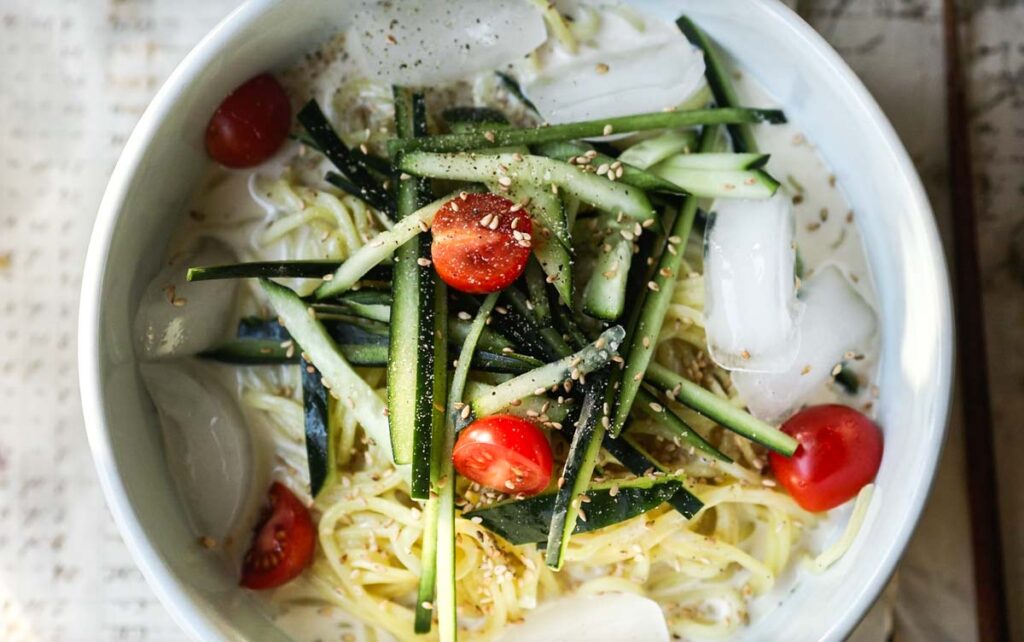
Cold. Creamy. Noodles.
This cold kong guksu recipe (soybean noodles) is one of the most satisfying and refreshing noodle dishes you’ll ever have.
And the best part is how absolutely EASY it is to make!
Not only that? The soy milk you make for this recipe will also be your favoritest milk!
Kong guksu is a staple of Korean cuisine and wouldn’t ya know it–it’s an entirely vegan dish! This mainstay of Korean food thus fits very well into a plant-based diet.
So, without further ado, let’s get into it!
Disclaimer: Some of the links in this post may be affiliate links for products I use and love. If you make a purchase after clicking one of those links, I may earn a small affiliate commission, perhaps enough to buy some extra gochujang or gochugaru 🙂
What is “Kong Guksu” or 콩국수?
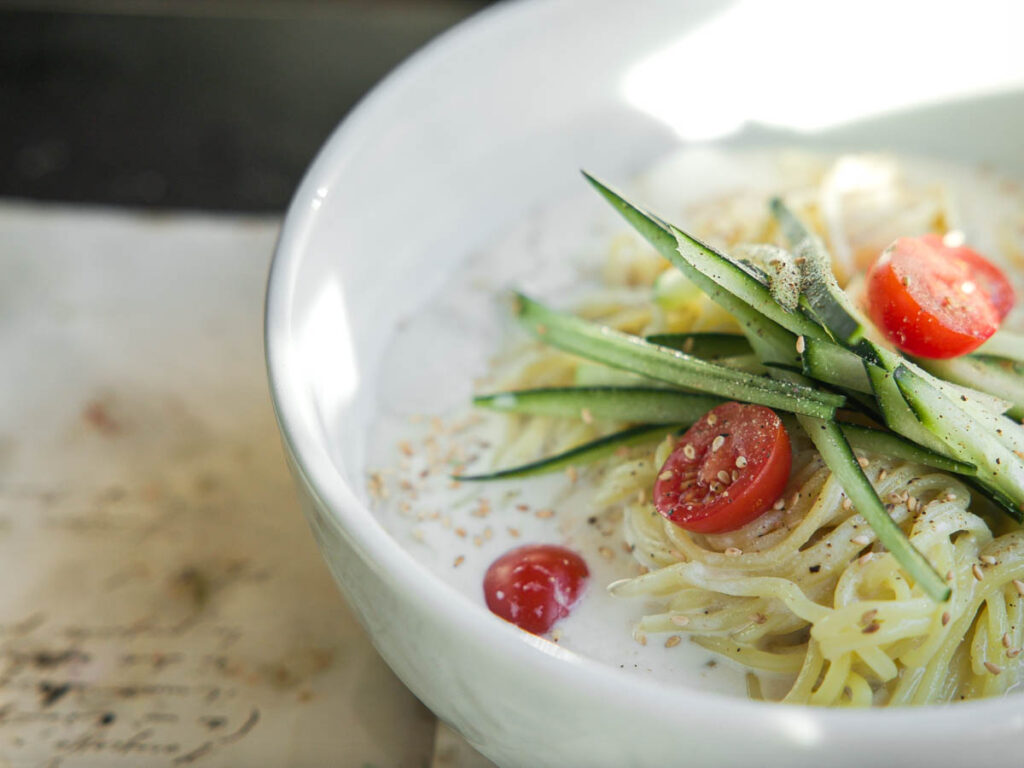
“Kong” or 콩 literally translates into “bean.” In this case, the “bean” is soybean. “Guksu” or 국수 is, as we’ve discussed before, “noodles.” Hence, “kong guksu” literally means “bean noodles.” Does that mean that the noodles themselves are made out of soybeans? No (though, wouldn’t that be pretty cool…?). Rather, the noodles are steeped inside a rich, homemade soy milk soup or soy milk broth.
Kong guksu is one of the most popular noodle dishes in Korea, particularly on hot summer days. Why? Because the soybean soup is usually served ice cold. In fact, many kong guksu recipes (including this one) call for the inclusion of ice cubes directly in the broth!
On our last trip to Korea, my father was insistent that we go to a traditional Korean restaurant that specializes in kong guksu. Unfortunately, it turned out to be not that good…? While the noodles themselves were fine, the broth was a bit bland and too heavy for all of us. I instantly wanted to get back to my kitchen and make a better version of this Korean dish.
Why You’ll LOVE This Kong Guksu Recipe.

You’re going to love this kong recipe because:
- Few Ingredients. This kong guksu recipe has only 9 ingredients, many of which you may already have!
- Easy. Once you’ve soaked your soybeans (which takes almost zero labor on your part), this noodle dish comes together so quickly! It’s practically as easy as instant ramen noodles!
- Hearty. Because this cold noodle soup is made with blended whole soybeans, you’re getting a ton of fiber and protein. As such, this is not one of those dishes that’ll leave you feeling inexplicably hungry afterwards!
- Refreshing. Did I mention this kong guksu recipe calls for ice cubes? This noodle dish is both satisfying and refreshing, and you’ll LOVE slurping them during the hottest days of summer!
- Versatile. The homemade soy milk included in this kong guksu recipe is going to introduce you to the best plant-based milk you’ve ever had in your life. You’ll want to use it for everything–oatmeal, cereal, pasta sauces, and more!
Key Ingredients and Notes on Substitutions for Kong Guksu.
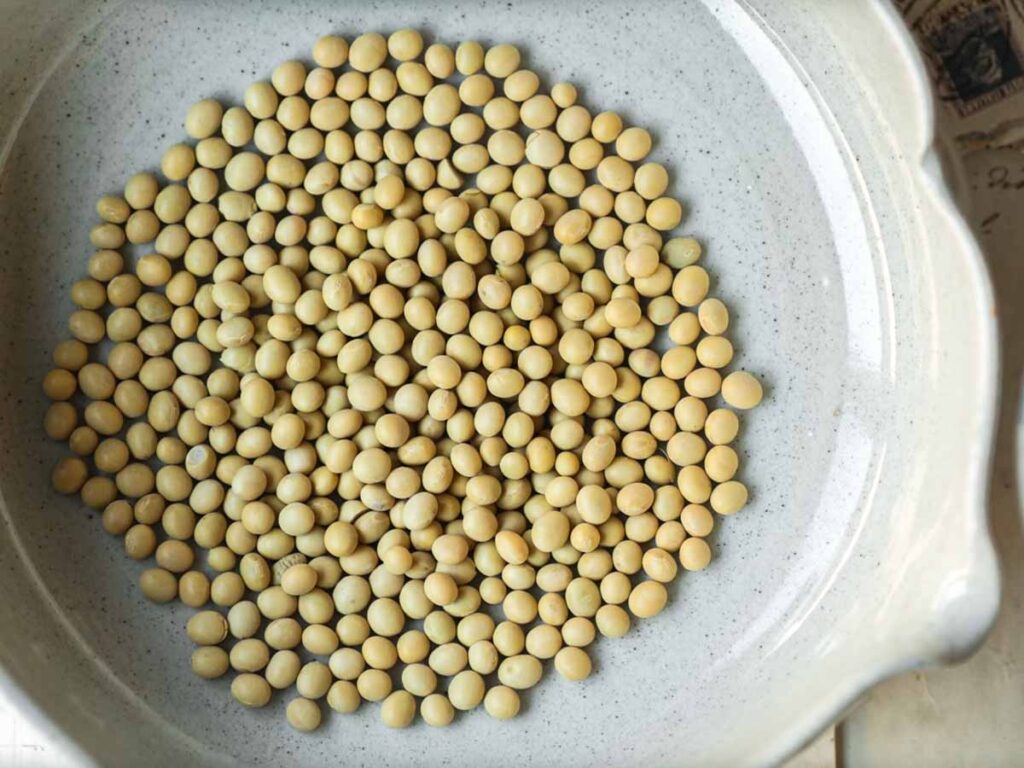
This kong guksu is made from very simple ingredients and therefore, won’t have many substitutions, but let’s run through them anyway:
- Soybeans. “Kong” literally means “bean,” and in this case, refers to yellow soybeans or “meju kong” (메주콩) or “baektae” (백태). For this recipe, you will want to pick up dried yellow soybeans. There really is no substitute for soybeans in a cold soy milk noodle soup recipe! Do not substitute with other kinds of beans–it might be a bean soup and it might be delicious, but it won’t be Korean kong guksu! You can pick these up at the Korean grocery store, online, or even at many Western style grocery stores!
- Noodles. I’ve seen many different kinds of noodles used for kong guksu. Many people suggest using somyeon or Korean thin wheat noodles, like we do in Cold Bibim Kimchi Noodles. If you’d like to keep this recipe gluten-free, you can use these gluten-free rice somyeon (a fan of the blog recently used these upon my recommendation and can vouch for how good they are!). I’ve also seen Korean restaurants use Chinese style noodles (like what you would use for jjajangmyeon) or kahl guksu, Korean knife cut noodles. My point is, you can pretty much use whatever kind of noodle you like!
- Pine Nuts. Pine nuts will add a delicious, nutty richness to the soy milk for this kong guksu recipe. If you cannot use pine nuts or have a nut allergy, you can substitute with sunflower seeds.
- Toasted Sesame Seeds. Toasted sesame seeds are such a huge part of Korean cuisine, so it’s no surprise that it enhances the flavor of our soy milk here. Definitely get toasted sesame seeds (not raw ones). If you can’t use sesame seeds, I would just replace with more pine nuts or simply omit them.
- Medjool Dates. This homemade soy milk is naturally sweetened with dates. I love the mellow hint of sweetness that the dates provide. If you don’t have dates, you can also substitute with your favorite liquid sweetener (maple syrup, brown rice syrup, coconut sugar, etc.).
- Cucumber. To keep the kong guksu refreshing, this recipe includes julienned cucumber as a garnish. I would not skip these–the soy broth is very thick and creamy and you’ll want something to cut through it. The cucumber makes a huge difference!
- Cherry Tomatoes. Not only will they add a gorgeous splash of color, the tomatoes will add a burst of flavor, tartness, and umami to your broth! If you don’t have cherry tomatoes, feel free to substitute with whatever variety of tomatoes you have!
Step-by-Step Instructions on Making Kong Guksu.
One of the best things about this recipe is how easy it is. As you’ll see below, this kong guksu recipe takes very little work and, once you’ve made your own soy milk, comes together as easily as 1, 2, 3!
First, make your soy milk by pouring your dried soybeans into a large bowl, together with filtered cold water. These beans will need to soak overnight. After their overnight soaking, the next day, they will be plump and shiny, and you’ll notice that there’s a lot less water!
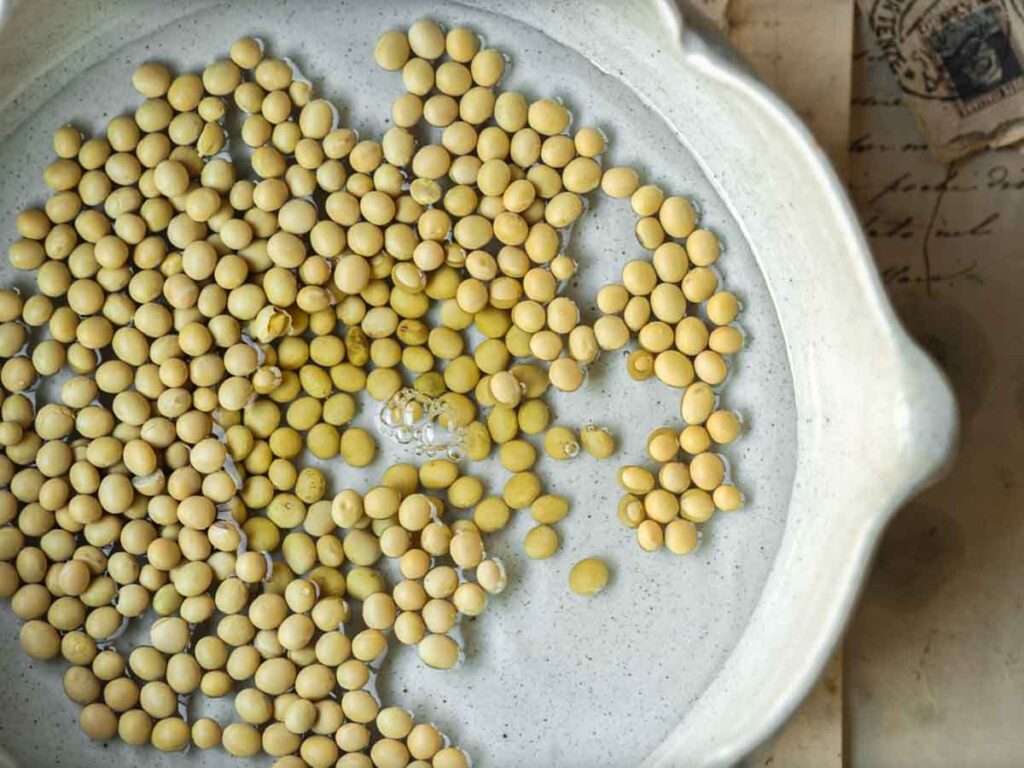
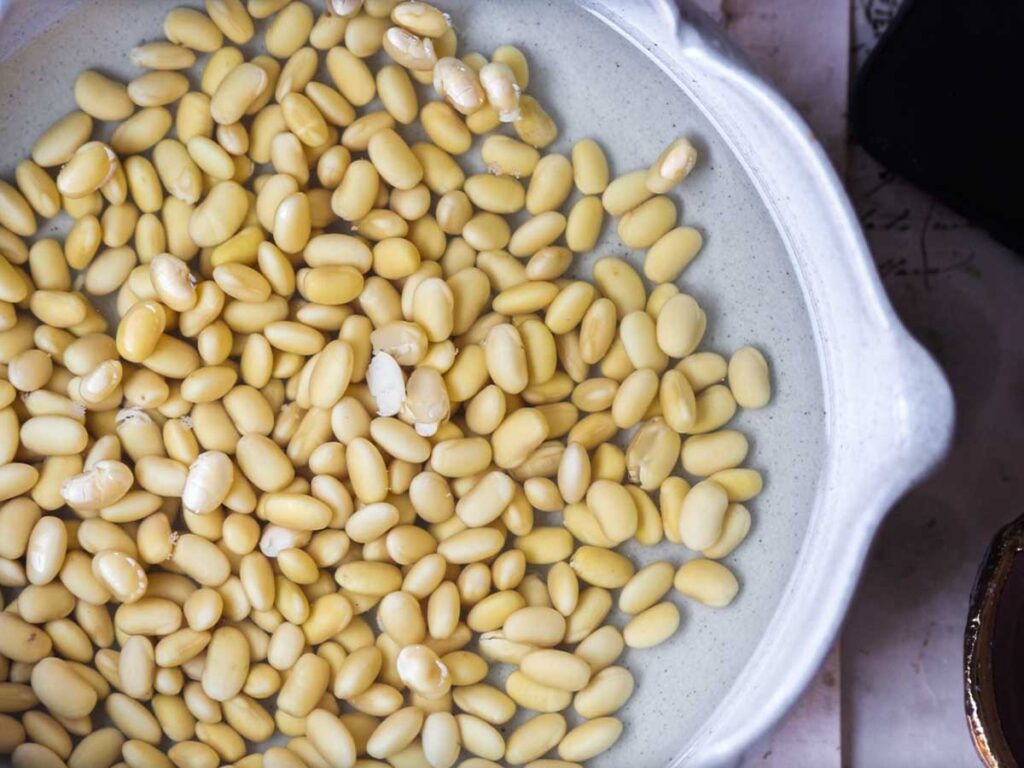
Drain any excess water and place them in a medium pot with water over high heat. Once the water comes to a roiling boil, reduce to medium heat and cook for an additional 20 minutes, until the soybeans start to grow soft (they will not be fork tender). DO NOT DRAIN THE BEANS YET!
Reserve 1/2 cup of the bean water before draining and rinsing the cooked soybeans. Then, place the cooked beans into a high-powered blender, together with the reserved bean water (poured through a sieve or strainer to catch any shells from the beans), 2 1/2 cups of water, pine nuts, sesame seeds, pitted dates, and a little sea salt. Blend on high for about 1 minute, until completely smooth, extra creamy, and frothy.
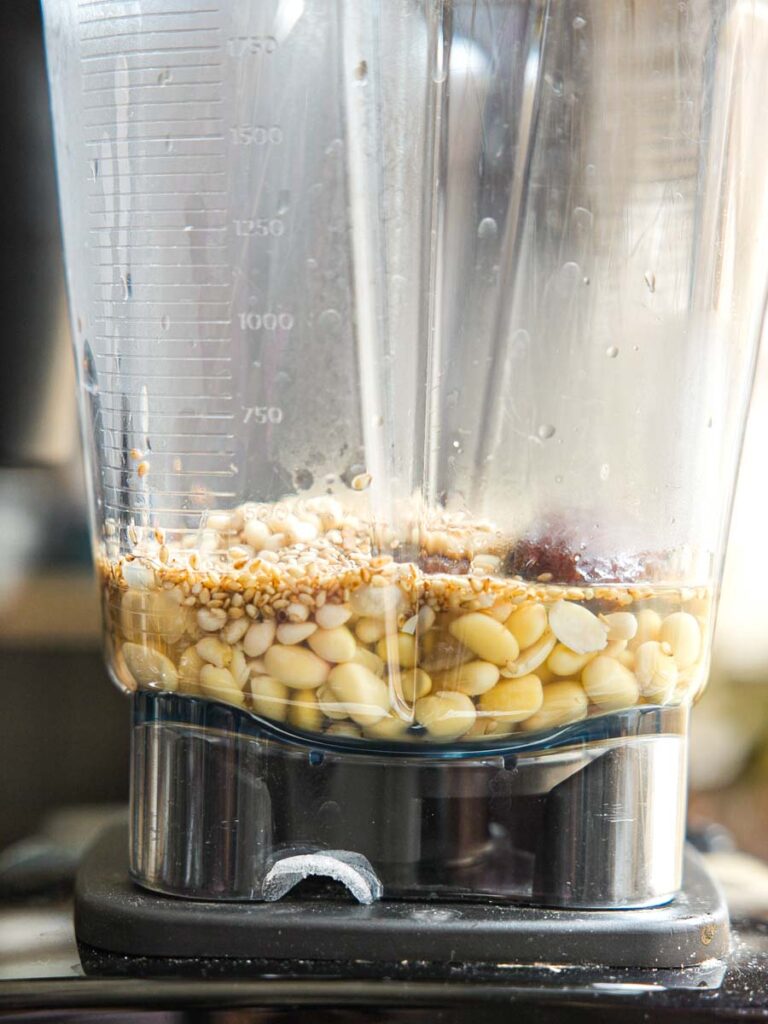
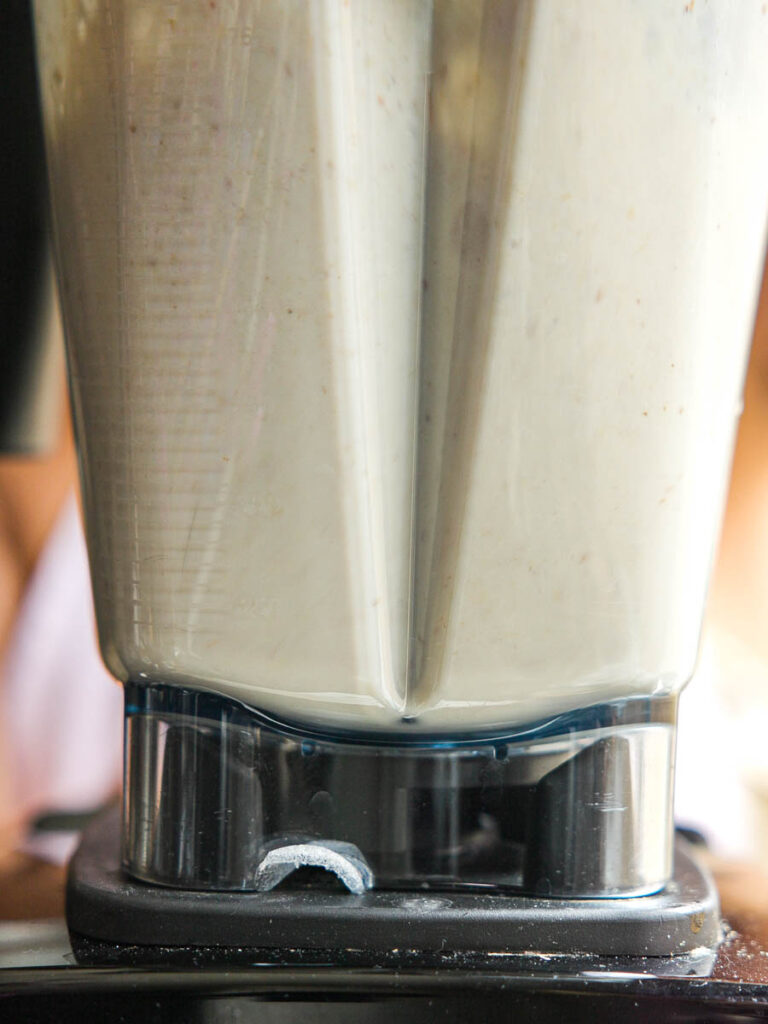
Voila–the BEST soy milk you’ve ever had in your LIFE. I PROMISE.
Now, to assemble the dish, cook your noodles according to pack instructions. While your noodles are cooking, place your soy milk in the fridge and slice up or julienne some cucumber, as well as some cherry tomatoes.
When your noodles are cooked, drain and rinse them under cold water. Place them in your serving bowl. Then, pour 1 to 1 1/2 cups of your soy milk over the noodles. Garnish with cucumber slices or cucumber sticks, the tomatoes, cracked black pepper, a pinch more sea salt, and toasted sesame seeds.
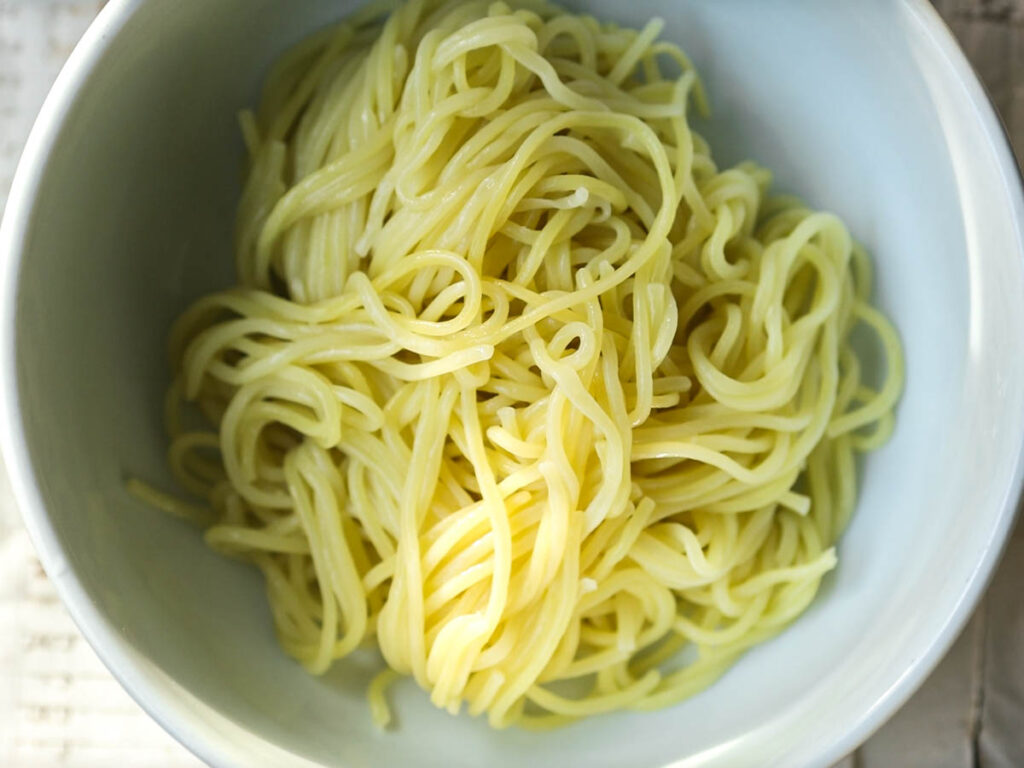
The very last step for this kong guksu recipe? Ice cubes! Throw a handful of them directly into your bowl so that your soy soup remains chilled!

Storing Your Homemade Soy Milk.
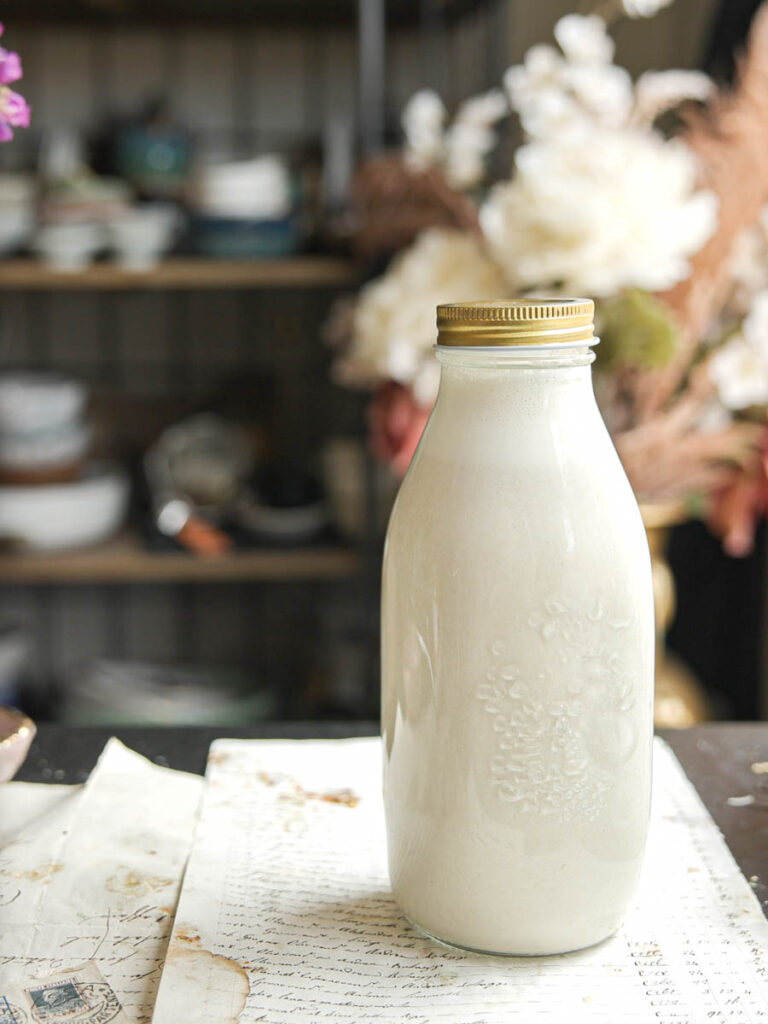
Just place your homemade soy milk in an airtight container (like a mason jar or milk bottle) and stick it in the refrigerator. Your soy milk should stay good for up to two weeks!
Fun Ideas for Your Kong Guksu.
This is a very traditional recipe for kong guksu. However, you don’t have to stick to it! That’s the great thing about this recipe–it’s so versatile! Here are some fun twists on your kong guksu:
- Ramen Noodles. Like I said, you can pretty much use whatever noodles you like. Why not use instant ramen noodles? Simply nix the soup packet, cook the noodles with the dehydrated veggie packet, and add your soy milk!
- Serve it Warm. Just because kong guksu is typically served cold doesn’t mean it MUST be. Heat your soy milk up in a microwave safe bowl and pour it over your cooked noodles for a warm, satisfying bowl of noodles!
- Add More Veggies. Don’t limit yourself to cucumbers and tomatoes! Go crazy–add raw bell peppers, sauteed onions and zucchini, fresh herbs!
Frequently Asked Questions.
Can I use store-bought soy milk to make kong guksu?
While homemade soy milk is preferable for authentic kong guksu, yes, you can use store-bought soy milk. Make sure to pick up a plain soy milk (unsweetened) or a Korean soy milk.
Can I make this recipe gluten-free?
Yes! The homemade soy milk is already gluten-free. To keep this kong guksu recipe gluten-free, simply use gluten-free noodles. You can find my suggestion in the Ingredients section above!
My kong guksu is bland–did I do something wrong?
Probably not! Look, kong guksu is meant to be a hearty, refreshing, and healthy dish–it isn’t meant to be a total flavor bomb like Korean fried chicken! That said, kong guksu is typically served with some really good kimchi, which adds an excellent contrast in flavor and texture, while cutting through the richness of your creamy broth.
Recipe Card.
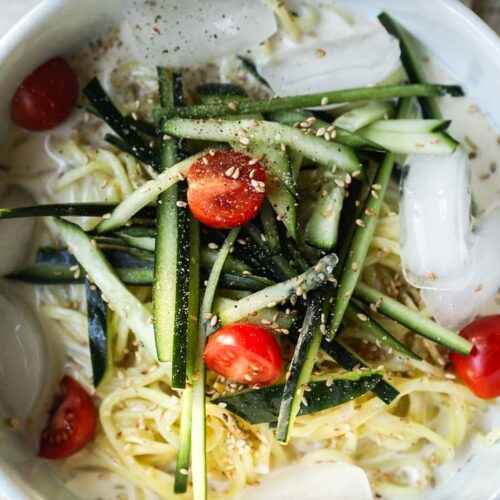
Easy & Authentic Cold Kong Guksu (Soybean Noodles)
Equipment
Ingredients
Homemade Soy Milk.
- 1/2 cup dried yellow soybeans
- 1/4 cup pine nuts
- 2 tbsp toasted sesame seeds
- 2 medjool dates, pitted
- 1 tsp sea salt
Noodles.
- 16 oz somyeon (can sub in your favorite noodles)
- 2 cucumbers, julienned
- 2 cups cherry tomatoes, halved
- 2 tsp cracked black pepper
- 1 tsp sea salt
- 1/4 cup toasted sesame seeds
Instructions
Homemade Soy Milk.
- Add the dried soybeans to a large bowl together with 2 1/2 cups of filtered water. Let it soak overnight. The next day, your beans will be plump and most of the water will have been absorbed. Drain and set aside.
- Add 2 cups of water to a medium pot, together with the rehydrated soybeans, over high heat. When the water comes to a boil, reduce heat to medium and let it cook uncovered for another 20 minutes, until the soybeans grow soft (not fork tender).
- Reserve 1/2 cup of the bean water and drain the rest. Rinse your cooked beans and place them in a high powered blender. Add your bean water through a sieve or strainer (to catch any shells that came off during the boiling). Next, add your pine nuts, sesame seeds, dates, and salt, together with 2 1/2 cups of filtered water. Blend on high for 1 minute, until totally smooth, creamy, and frothy.
Noodles.
- To assemble your noodles, cook your noodles according to package instructions (e.g., for somyeon, add noodles to boiling water and cook for 3 to 4 minutes). Drain and rinse under cold water. Divide noodles into four servings.
- Pour equal amounts of soy milk (about 1 1/2 cups) over your noodles. Garnish with julienned cucumber, tomatoes, black pepper, salt, and sesame seeds. Add a handful of ice cubes to each bowl to keep the soup chilled throughout.




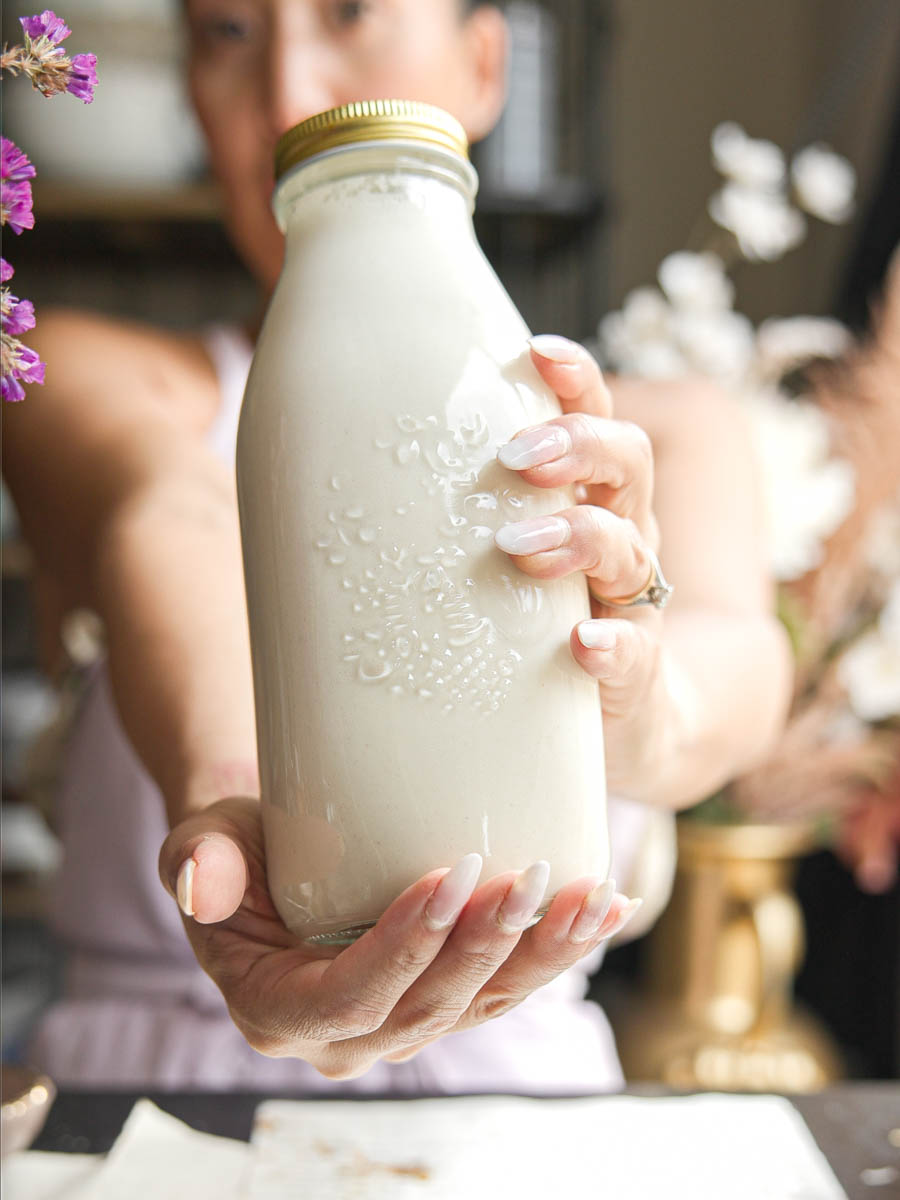
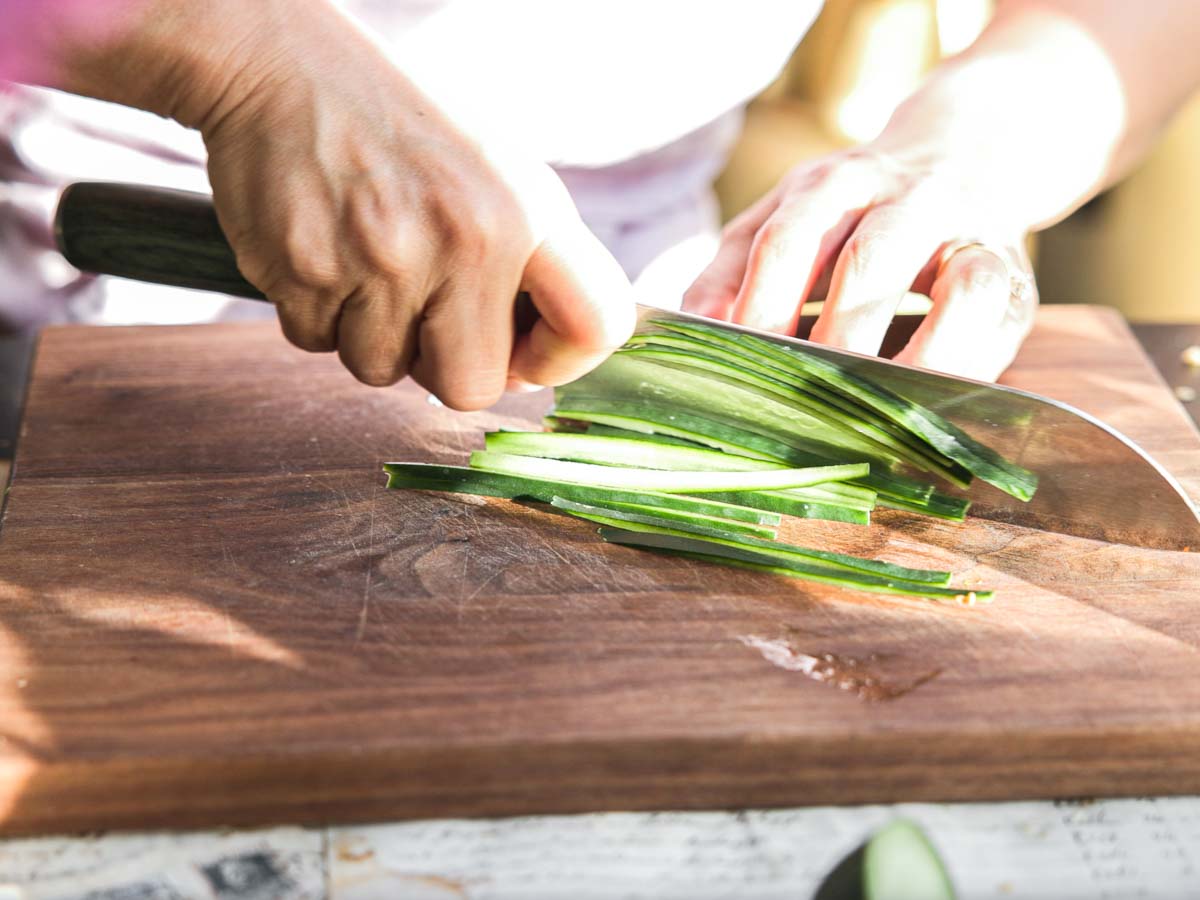

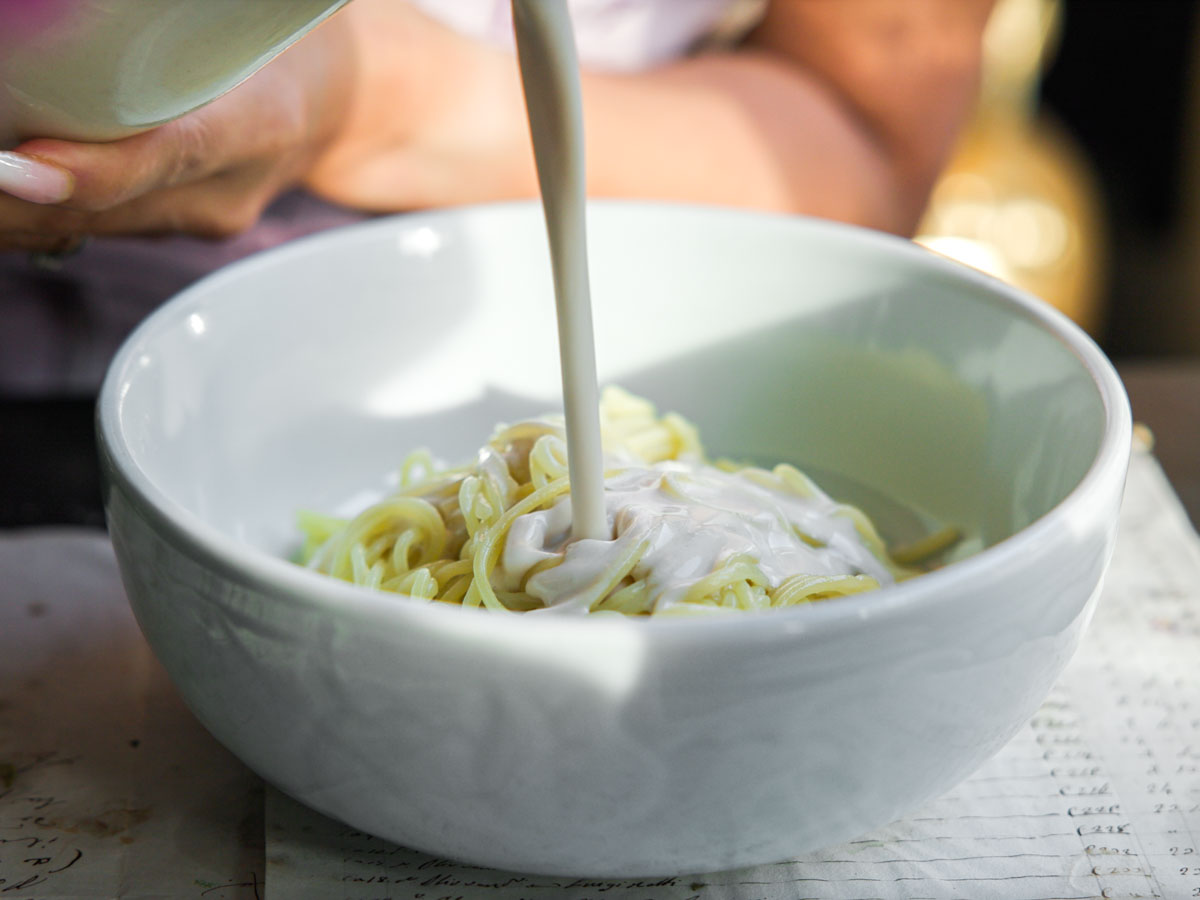
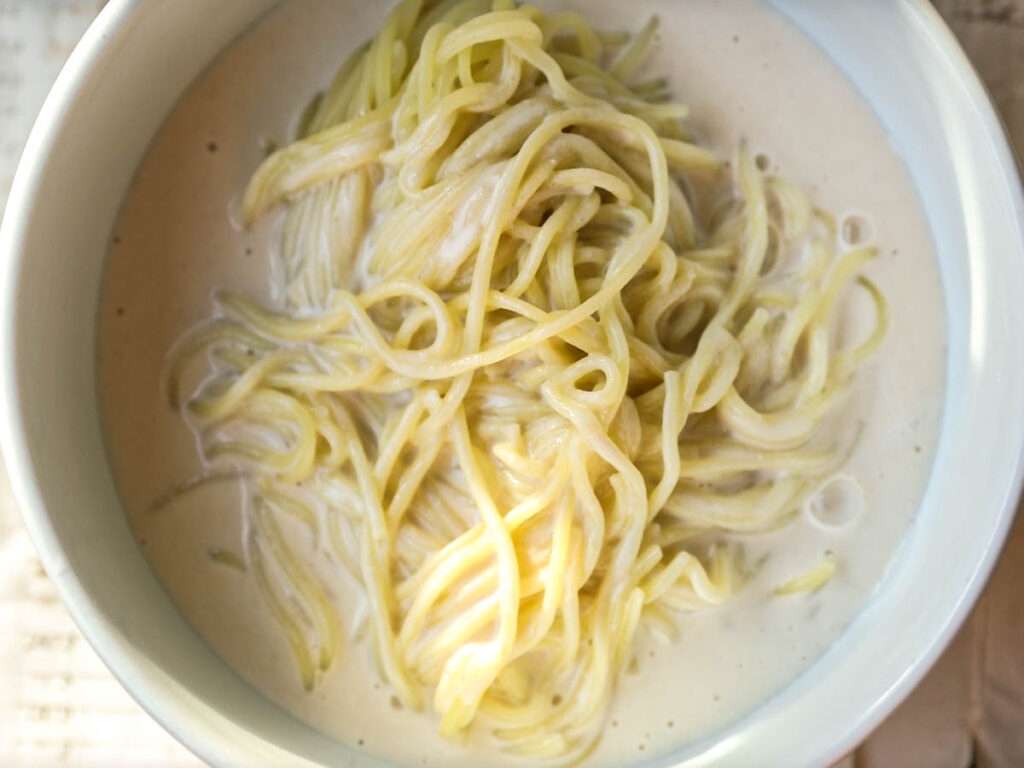


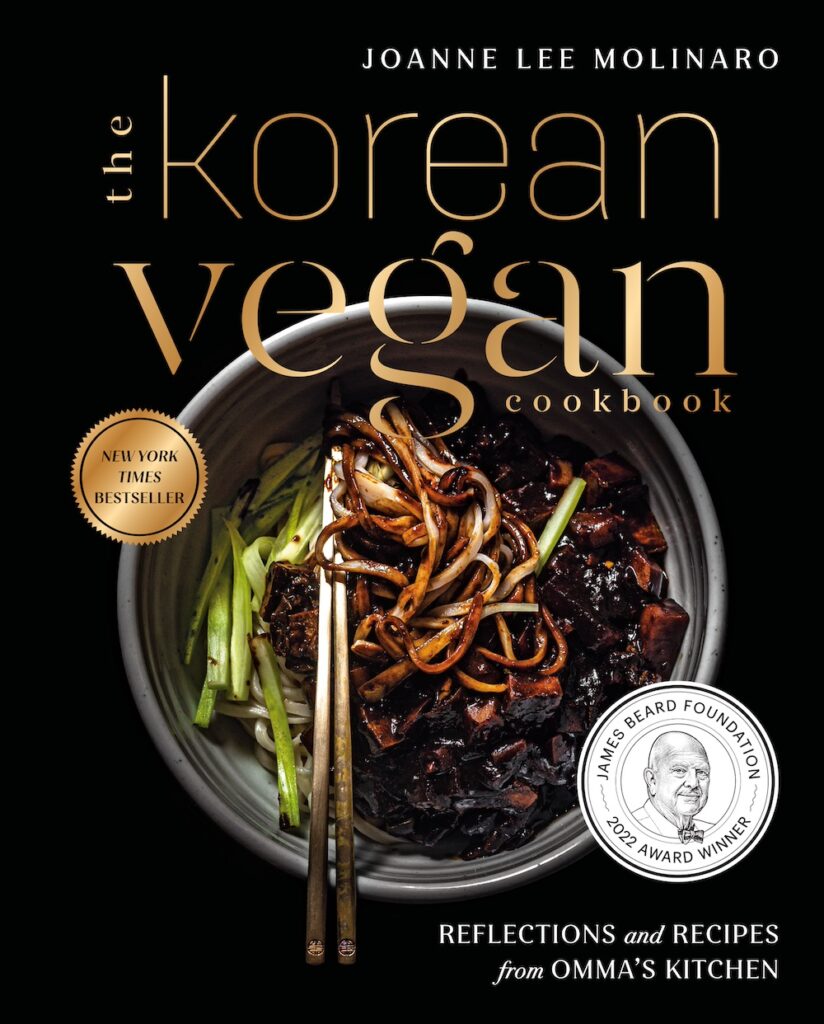
Hi Joanne, the beans didn’t soak up the water overnight and they are not getting fork tender. Did my partner actually buy the wrong ones? They are more white than yellow. I will try to cook them longer and see what will happen.
Sorry Joanne, I misread the recipe ?. It turned out well, thanks for always sharing great recipes and stories!
Thank you for sharing your story and your facts about North Korea makes my heart ache for those that live in darkness and can’t reach out. I can’t even imagine. The recipe looks great! Just the other week I made the zucchini kimchi thanks to you. Love your recipes and all your stories. Thank you! ??